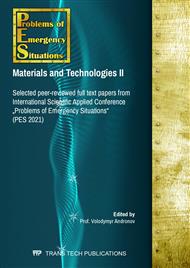[1]
R.P. Alpatkina, Issledovanie vlahoprovodnosti drevesiny hlavnykh otechestvennykh porod: dys.nasoisk.uchen.stepeni cand.tekhn.nauk:spets.05.21.05.M. (1970) 210 s.
Google Scholar
[2]
Brian H. Bond, Omar Espinoza, A Decade of Improved Lumber Drying Technology. Curr Forestry Rep. 2 (2016) 106–118.
DOI: 10.1007/s40725-016-0034-z
Google Scholar
[3]
K. Folvik, S.K. Magnar, Various wood properties influencing the development of checks in knots during drying. Advances in drying of wood. NTI-papers from COST-E15 seminars 2000-2004, (2004) 99 p.
Google Scholar
[4]
M. Hasan, T. A. G Langrish, Development of a sustainable methodology for lifecycle performance evaluation of solar dryers. Solar energy. Pergamonelsevier science ltd. 135 (2016) 1–13.
DOI: 10.1016/j.solener.2016.05.036
Google Scholar
[5]
M. Hasan, T.A.G. Langrish, Time-valued net energy analysis of solar kilns for wood drying: A solar thermal application. Energy. 96 (2016) 415–426.
DOI: 10.1016/j.energy.2015.11.081
Google Scholar
[6]
A.H. Horokhovsky, Tekhnolohia sushki pilomaterialov na osnove modelirovania i optimizatsii proysessov teplomassoperenosa v drevesine: avtoref. dys. na soisk. uchen. stepeni cand. tekhn. nauk: spets. 05.21.05. Ekaterinburh, (2008) 39 s.
Google Scholar
[7]
A.A. Kosarin, Tekhnolohia ompulsnoy sushki pilomaterialov:avtoref.dys.na soisk.uchen.stepeni cand.tekhn.nauk:spets.05.21.05.M., (2012) 22 s.
Google Scholar
[8]
P.V. Lubovitsky, Sushka drevesiny s tsyklovym prohrevom (Opyt raboty predpriatiy).M.:Lesnaya promyshlennost, (1986) 56 s.
Google Scholar
[9]
A.V. Lykov, Teplo i massoperenos v processe sushki. M.: Hosenerhoizdat, (1956) 464 s.
Google Scholar
[10]
G. Miliü, B. Kolin, Oscillation drying of beech timber – initial experiments. End user's needs for wood material and products. The Netherlands, (2008) 115–124.
Google Scholar
[11]
M.H. Minhazov, N.V. Kachalin, Ostsyliruyushchie rezhymy sushki pilimaterialov. M.:VNIPIEIlesprom, (1976) 49 s.
Google Scholar
[12]
I.M. Ozarkiv, Z.P. Kopynets, Y.L. Atsberher, Metodyka doslidzhennia kryteriu Kirpichova yakosnovnoho kryteriu trishhchynoutvorennia u protsessi convectyvnoho sushinnia derevyny. Nauovyy visnyk NLTU Ukraine. 16.2 (2006) 81-85.
Google Scholar
[13]
O. Pinchevska, V. Holovach, V. Koval, V. Boriachynskiy, Sposib sushinnia derevyny. Patent № 2016 u 06568, (2016).
Google Scholar
[14]
O. Pinchevska, A. Spirochkin, J. Sedliacik, R. Oliynyk, Quality assessment of lumber after low temperature drying from the view of stochastic process characteristics. Wood Research. 61.6 (2016) 871–884.
Google Scholar
[15]
H. Pleschberger, CH.Tian Hansmann, UL.H Muёller, A. Teischinger, Fracture energy approach for the identification of changes in the wood caused by the drying processes. Wood Sci Technol. 47 (2013) 1323–1334.
DOI: 10.1007/s00226-013-0578-z
Google Scholar
[16]
R. Remond, P. Perre, Drying strategies capable of reducing the stress level of a stack of boards as defined by a comprehensive dual scale model. Maderas Ciencia y tecnología. 10 (2008) 3–18.
Google Scholar
[17]
J.-G Salin, A Theoretical Analysis of Timber Drying in Oscillating Climates. Holzforschung. 57 (2003) 427–432.
DOI: 10.1515/hf.2003.063
Google Scholar
[18]
P.S. Serhovsky, A.I. Rasev, Hydrotermicheskaya obrabotka i conservirovanie drevesiny. M.:Lesnaya promyshlennost, (1987) 360 s.
Google Scholar
[19]
H.S. Shubin, Sushka i teplovaya obrabotka drevesiny. M.:Lesnaya promyshlennost, (1990) 336 s.
Google Scholar
[20]
E.E. Shyshkina, Sushka pilomaterialov v camerakh maloy moshchnosti s estestvennoy tsyrkulatsiey vozdukha: avtoref. dys. nasoisk. uchen. stepeni cand. tekhn.nauk: spets.05.21.05. Ekaterinburh., (2006) 20 s.
Google Scholar
[21]
M.U. Tepnadze, Rekzymy I tekhnolihia sushki pilomaterialov v heloisushylkakh:avtoref.dys.nasoisk.uchen.stepeni cand.tekhn.nauk:spets.05.21.05.M., (1986) 18 s.
Google Scholar
[22]
I.S. Vintoniv, I.M. Sopushynsky, A. Teischinger, Derevynoznavstvo.Lviv.: Apriori, (2007) 312s.
Google Scholar
[23]
J. Welling, T. Riehl, W. Zerhau,e ts., Oscillating Drying Conditions. Technical report, (2004) 28s.
Google Scholar
[24]
V.H. Zakharzhevsky, Skorostnaya sushka drevesiny. M.:Lesnaya promyshlennost, (1948) 32 s.
Google Scholar


